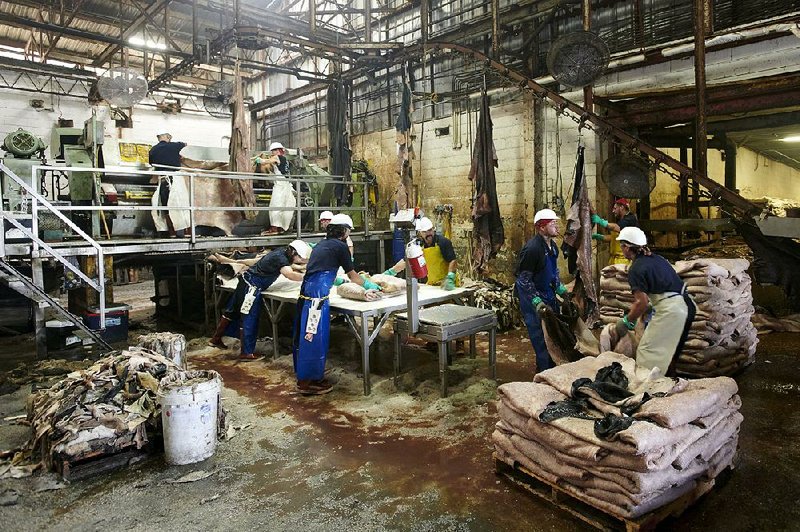The U.S. merchandise-trade deficit widened to a record in September while orders for business equipment declined for a second month, adding to signs that an escalating tariff war is starting to constrain economic growth.
The gap in goods trade rose to $76 billion from $75.5 billion as gains in imports outpaced exports, Commerce Department figures showed Thursday, with both categories potentially reflecting shipments rushed to beat tariffs between the U.S. and China. A separate report from the department showed orders at U.S. factories for non-defense capital goods, excluding aircraft, unexpectedly fell last month.
While analysts said the slowdown in business equipment may be natural after several months of strong figures, the figures suggest that investment has less momentum heading into the fourth quarter, after getting a boost earlier in 2018 from tax cuts.
Meanwhile, the trade data reinforced forecasts that net exports were probably a significant drag on third-quarter economic growth, ahead of today's report on gross domestic product.
"You have imports pretty strong the last month or two, and particularly last month, and so some of that may actually be front-loading of imports ahead of expectations that tariffs will pick up," said Michael Feroli, chief U.S. economist at JPMorgan Chase & Co. in New York. The report on factory orders "does set up a path for a little bit softer [capital expenditure] growth" in the fourth quarter, he said.
The economic reports followed a string of company comments that sent stocks tumbling earlier this week.
Caterpillar Inc., an economic bellwether, said manufacturing costs were higher due to rising material and freight costs, while 3M Co. sank the most in about six months as adverse exchange-rate moves and high material prices compounded slumping sales in its electronics, health care and consumer products businesses.
The trade figures showed imports rose $3.1 billion from the prior month, or 1.5 percent, and exports climbed $2.5 billion, or 1.8 percent. While some of the import gains may be related to front-running tariffs, solid consumer and business confidence are underpinning demand for foreign-made goods.
The U.S. and China last month imposed their latest round of tariffs on each other, which followed tariffs implemented in July and August.
The latest report adds to signs that U.S. companies rushed to get Chinese products in before the White House on Sept. 24 imposed the 10 percent tariff on $200 billion in Chinese goods, which caused Beijing to impose duties on $60 billion of U.S. products. The back-and-forth has resulted in tariffs on some $360 billion in annual two-way trade.
With the U.S. tariff rate set to rise to 25 percent in January, "shippers still have an incentive to rush goods in," and executives at U.S. ports say that's what's happening, according to Stephen Stanley, chief economist at Amherst Pierpont Securities LLC.
"Exports face the headwinds of an appreciating dollar and retaliatory tariffs, while imports are surging now with the likelihood of a steep falloff in early 2019," Stanley said in a note.
The business-equipment report showed overall durable-goods orders unexpectedly rose 0.8 percent on a surge in bookings for military aircraft and parts, which Bloomberg Economics says is a temporary result of the federal budget passed earlier this year. But orders fell for electrical equipment, appliances and components, while orders for computers and electronic products were unchanged. Categories with gains included motor vehicles and parts, as well as machinery.
The category that serves as a proxy for business investment dipped 0.1 percent in September after a 0.2 percent fall in August. The recent weakness in investment orders has raised concerns about whether the growing trade war with China and stock market volatility were making businesses more cautious.
The government will provide its first estimate of overall economic growth in the July-September quarter today. Economists are projecting that the growth in the gross domestic product slowed to an annual rate of 3 percent in the third quarter after a sizzling 4.2 percent annual growth rate in the April-June quarter, the best in nearly four years.
President Donald Trump often cites the gross domestic product gains as evidence that his economic policies are working. But many private economists believe the support from the $1.5 trillion tax cut passed by Congress last December will start to fade next year.
The durable-goods report showed that demand for autos was up a solid 1.3 percent, while demand for military aircraft rose 119.1 percent but orders for commercial aircraft fell.
Orders for machinery increased 0.8 percent while demand for primary metals such as steel rose 0.1 percent. Demand for computers fell 0.4 percent while orders for communication equipment slipped 0.1 percent.
In a separate report, the Labor Department said that new applications for unemployment benefits rose 5,000 last week to a still-low 215,000. Benefit applications, which are a proxy for layoffs, had been down by 5,000 in the previous week.
Information for this article was contributed by Jenny Leonard, Sarah Foster, Katia Dmitrieva, Randall Woods, Jeff Kearns and Jordan Yadoo of Bloomberg News and by Martin Crutsinger of The Associated Press.
Business on 10/26/2018

